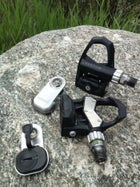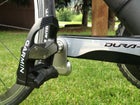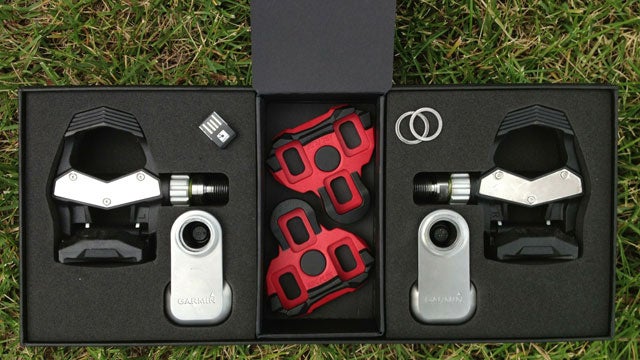After almost three years since showing prototypes of its pedal-based power meter system, Garmin has released the product to market. isn’t the first system to collect power data through the pedals. (That honor goes to the .) However, Vector appears to be the most universal and, judging by the two days we’ve had with them so far, robust system available.
Living the Cycle Life
More bike and gear reviews from Aaron Gulley The pedals and pods
The pedals and pods Mounted on the crank
Mounted on the crankGarmin rolled out the product at an intimate launch in Boulder, Colorado, where six editors from the cycling media got a chance to speak directly with the developers and to ride production models of the pedals. And though the project has been beset by delays—mostly due to the complexity of the task and of beta testing to get the pedals just right, according to Garmin—Vector is in production and hitting stores this week.
The advantages of a pedal-based power system are numerous. The most obvious is the simplicity of set-up: installation is as simple as tightening the pedals onto your cranks. “It’s the first system that allows a consumer to walk into a store, purchase a power meter, install it himself, and get riding immediately,” said Clark Foy, one of the founders of Metrigear, whose startup product Garmin purchased and developed into Vector.
Because setup is such a snap, Vector can be easily switched between bikes in a matter of minutes, for instance between road and TT setups. The pedal design also means that, unlike most other power meters out there, Vector doesn’t tie you to a particular crank length or wheel design. (Though, in fairness, since Vector is built around the Look Ko platform, it does limit your pedal option.)
Vector also gathers more information than most existing power devices. Because both pedals house separate meters, the unit can display distribution of power between the right and left legs, a metric that can help assist riders in developing more even, efficient pedaling.
Foy sees that as the future, both of power meters and of Vector. “This is just version one,” he said at the unveiling. “Watts is interesting for a subset of the market, but the data goes far beyond that. Power balance is a fairly straightforward metric, but Ican also see things like where people are putting pressure on the pedals. The future implications for fitting and efficiency are huge.
Overview
The Vector System is comprised of two components: the pedals, a Look Keo-compatible platform that is manufactured by Exustar, and the pedal pods, which contain the ANT+ communication devices that send data to the head unit. Also included is a pair of Keo cleats, a USB stick for firmware updates, and a bag of spacers and hardware for installation. Vector is compatible with Edge 500, Edge 510, Edge 800, and Edge 810 head units, as well as any other ANT+ compatible head unit on the market (though all features may not be available on non Garmin computers.) Head units must be purchased separately.
Each pedal contains strain gauges and accelerometers, all housed in the spindle of the pedal. The pods also contain accelerometers and small watch-style batteries for powering data transmission, which Garmin claims will last for 175 hours each. The pedals work in a master-slave configuration, so the left pedal delivers data to the right and the right pedal transmits to the head unit.
Installation is simple: Place a pedal pod and a washer onto the spindle of the pedal, tighten the pedal as normal, aligning the pod straight down toward the ground, and, once tight, plug the rubber gasket from the back of the pod into the crank for weather sealing. Once the pedals are on the bike, you simply power up the head unit, in my case an Edge 810, which walks you through calibration with a series of prompts. It’s surprisingly easy, including a quick pedal around so the sensors can register the proper alignment, a push-button calibration, and a bit of back-pedaling for the final measurement. From box to ride, it took just five minutes for the initial installation and configuration.
First Ride
On my first test with the pedals, a 35-mile spin through the foothills north of Boulder, Vector worked flawlessly. Power displayed quickly and clearly to the head unit, and as always with the 810 (and other Garmin computers) changing up fields was simple and intuitive. I didn’t ride with a secondary power meter to check accuracy, but others on the ride who did reported that the numbers generated by Vector were consistent with existing meters, including SRM, Quarq, CycleOps, and Stages Cycling. The most interesting bit was the left-right balance, as it’s fascinating to see when inconsistencies in your pedal.
Back at the hotel, the 810 uploaded data to GarminConnect via Bluetooth, a nice function that’s very easy to get used to, and the data was clean, concise, and easy to parse. It all showed fine in Strava and Training Peaks, as well.
After the first day on the pedals, I was well impressed and all but convinced. However, day two wasn’t quite as smooth. It’s worth noting that the pedals remained just as they were from end of ride one to start of ride two. Pre-ride, I performed the 30-second calibration process (which you need to do every ride for accuracy). However on the bike, the power measurements were far too low and erratic, blinking on and off the screen.
I stopped a few times to recalibrate, however the issues persisted. After 20 minutes, I finally removed the batteries from the pedal pods—they pop out with the twist of a coin—and performed the five-minute setup process. This seemed to do the trick, and power numbers, cadence, and all other fields were accurate for the rest of the ride.
Conclusions
For simplicity and versatility, Garmin Vector has to be considered the best power meter option on the market. The setup is incredibly straightforward, and the ability to transfer the pedals between bikes quickly and easily is a boon for anyone with more than one bicycle. Though technically they would work on a mountain bike, the pedal pods protrude too much and would inevitably get broken by rocks and rough trails. Garmin says their next order of business is a mountain bike version of Vector.
I like that Garmin has made the system updateable via USB stick, so users can upgrade firmware as new features appear. The company also wisely built the connectivity and brains of the system into the pedal pods, meaning that as new technology becomes available (Bluetooth Low Energy, for instance) upgrades can be made with new pods ($69). So once you’ve made the initial investment, you should be covered. Finally, Garmin will offer rebuild kits for the pedals ($199), so your power meter won’t be kaput once you’ve worn out the bearings or cartridges.
Vector has two primary downfalls. First, because it’s built around the Look Keo, if you use Shimano, Time, Speedplay, or anything else you’ll be forced to switch systems. The Keo design is, of course, widespread and time-tested, but still, some riders may not be keen on getting forced into a gear choice.
The other disappointment of Vector is the $1699 retail price. That still makes it half the cost of meters from the likes of SRM and Quarq, but it also puts Vector significantly above new entries like Stages Cycling, which can be had for $700.
There’s Vector’s added convenience of quick switches between bikes to consider, as well as the additional data that pedals record. And the ease of compatibility with Garmin’s ubiquitous GPS units is another advantage. Still, I would love to have seen Vector priced more competitively.
The only other consideration is how stable Vector will be to start with. My experience with Garmin products is that they can be finicky on launch, and then the company nails the execution and reliability with firmware updates in the first six months. Garmin acknowledge some of these issues in the past, but they say they don’t expect that sort of issue with Vector. I believe them, but my day two ride was a touch worrisome. Hopefully, it’s just an anomaly.
I’ll be testing Vector comprehensively over the next months and will also be comparing the data to other power meters on the market. I’ll report back as I come to detailed conclusions. But given the system’s clean, well-thought-out, and convenient design, as well as Garmin’s excellent history with sporting electronics, I expect Vector to quickly become one of the most used power meters on the market.


